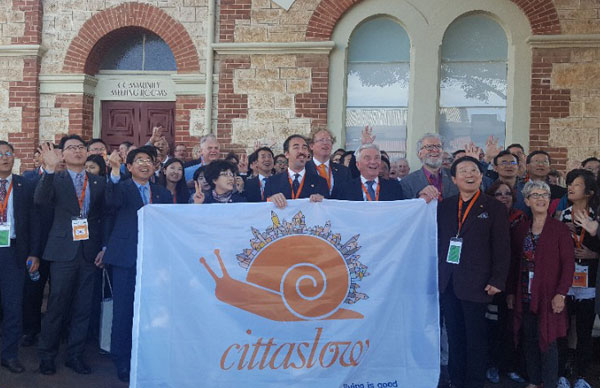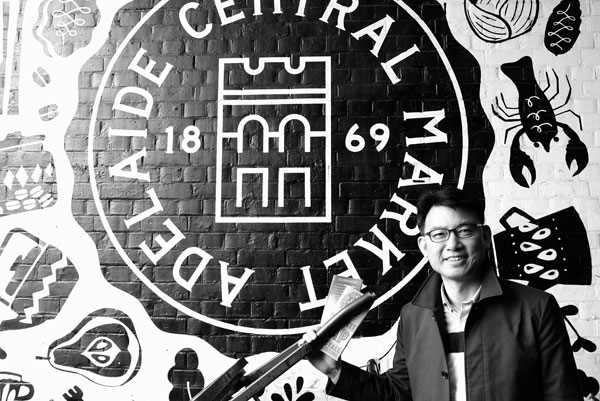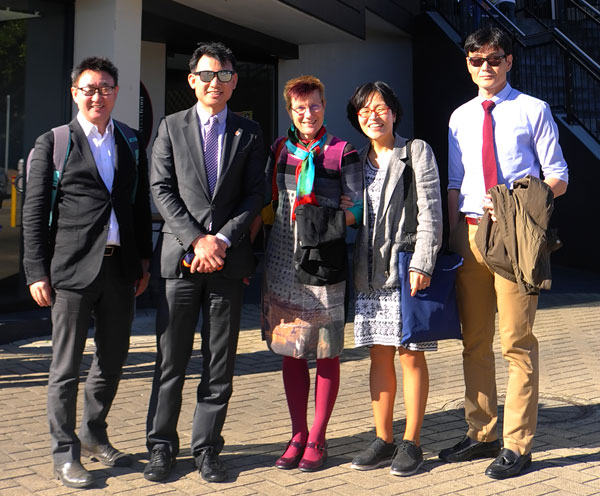In an Australian city of fine food, nothing is thrown away
By Choi Hyun-deok
Deputy Mayor, Namyangju city
I, along with Namyangju officials, flew southward for half a day. The first thing that I did upon arrival at Adelaide Airport of Australia was the act of peering into the distance. This was not because I meditated the Muse, but because I suffered much from fine dust back in Korea during May. The landscape around here came to me vividly as if fog filter was removed with twist.
The rural road leading to Goolwa, which was due to host the 2017 International Cittaslow Assembly, was beautifully colored by the setting sun. There are no signs of pollution except grasslands, forest and kangaroo roadkill signs. I felt that the continent of Australia is a big chunk of ecology resources.
Globally, about 230 cities have been rectified as slow cities. Roughly 200 people from 30 cities, including mayors, deputy mayors and senior officials, attended the International Cittaslow Assembly. There were lots of presentations on education, food culture and urban renewal in slow cities. A significant number of people coming from newly rectified cities in China were seen at the Assembly. Of note, Namyangju City won the top prize in the International Cittaslow Video Contest in recognition of its cine-poem presentation of slow life in the city.

I distributed to Assembly participants my greetings, which also included the agenda and significance of International Cittaslow Assembly slated for September 22 in Namyangju City. Many people showed interest in it. As a result, a bag, which contained printed material related to the Namyangju Cittaslow Assembly and giveaways, was empty. I used to carry a big bag when traveling overseas. After items included in my bags were cleared, they again bulged with items and books that I acquired on my overseas tour. This time was no exception.
Melbourne is known as a city of fine food. Shiras, the classic Australian red wine, is of high quality, albeit relatively low-priced. Queen Victoria Market is full of foodstuffs, clothing and miscellaneous things. I stopped in front of a winery in which customers can drink wine they like. Its management concept appears similar to that of grocerants which provide no wrapping paper. The market street, which is filled with foods of various countries, is brimming with people with different races as if to prove that Australia is an immigrant nation.
The Victoria Market marks a distinctive difference with Adelaide’s Central Market in which shops, albeit small in size, are full of local food ingredients. There are many stylish cafes in which people can drink wine, beer or coffee. I walked along to Degrave Street where I had a memorable night with fine food. In Seoul, noted places are floating like islands. We can go there only by car. Here in Victoria Market, properly situated shops and arcades connect the market street with tourist destinations.
Parks, statues and old buildings are eye-catching. Libraries, Catholic churches and fine art museums are factors that make the city balanced and beautiful. It seems that nothing can be thrown away in the city embedded in the history of immigration. Truly, this is a city which everyone is happy to walk along.

Sydney is no exception.
The reason that I headed to Sydney quickly through Melbourne after the Goolwa International Cittaslow Assembly wound up, was to fulfill two missions for Namyangju City. One was to identify the practical applications of eco-friendly smart system and the other was to explore the possibility of signing an MOU with the Australian University of Wollongong on the city’s core project, “slow life & dinning tour platform project.” In the morning after I arrived at Sydney, I left my hotel earlier to meet with Heather Yeatman, professor and president of Australia’s Public Health Association. He delivered a keynote speech on public health policy at the 2015 International Cittaslow Assembly.
The University of Wollongong is nestled in thick yucalyptus trees growing in New South Wales. As our tour team leader Park Soo-jin already agreed with Professor Yeatman on details of our Namyangju mission, meetings and a tour program at the university were conducted on schedule. Meanwhile, the Sustainable Building Research Center was well designed to worthy of its name. A study case which can be applied to daily living, such as sustainable energy, housing and home appliances, was underway between Professor Yeatman and his students.
The Sustainable Building Research Center was designed to apply the results of its experiments to upkeep of this building. The Early Start Discovery Space, located on the University of Wollongong, is Australia’s only dedicated children’s museum, offering interactive, playful experiences to inspire imagination and ignite a love of learning. As a hands-on creative learning venue, the Early Start Discovery Space has been specifically designed for children from birth to 10 years and their accompanying families, carers, educators and teachers.

The Discovery Space, which is built around a harbor and features historical achievements, suggests that a lot of research has been performed for its creation. Exhibitions are also impressive, with focus placed on the psychology of children who get practical experiences rather than impractical storytelling.
The slow life & food tour project requires the fusion of regional, ecological and food resources to become successful. The success and failure of this project relies on human resources development and job creation which are vital to economic revival. Food startups schools can be a core element of the dining tour platform. The annual salaries of blue-color workers are not lower than those of university professors. Only about 30% of high school graduates advance to colleges. This means that most people can gain access to the professional job training system and job opportunities.
Universities make contributions to advancement of the local communities and society with its diversity of curriculum. The outcome of meetings with professors, deans and school officials of University of Wollongong suggested that there is a high possibility of exchanges between the university and Namyangju City. Both sides promised to initiate consistent and concrete exchanges and cooperation for food startup business.

Here I had the finest lunch in Australia in my memory. A Harbour restaurant overlooking a port served fresh fish captured at nearby seas. This appears to be Professor Yeatman’s consideration for our dining tourists. Our tour peaked when we observed Greenhouse Park related to Biodiversity Food Project and Sustainability.
This park, made up with new and renewable energy facilities and community gardens, looks like an art work which expresses pains stemming from commodities produced in urban areas. The park is probably the best way of refuge disposal. The park occupies a unique space between an urban residential site and an industrial estate. While Korea drew attention from the globe for the development of Najni Park, this park apparently represents a more advanced third space. .
The Eatable Garden, a beautiful garden with multiple eatable vegetables, is a big jungle of eatables beyond imagination. In addition to common vegetables and fruits like tomatoes and bananas, Eatable Garden has all types of vegetables, such as wild flowers, aromas and those which can be used as food ingredients.
This garden, developed by three cities nearby, hosts a barbecue festival regularly. The most surprising fact is that the planning and management of the garden is implemented by partnerships between the cities and volunteer workers. The facility represents an ideal model for urban planning involving new towns, population concentration and housing expansion.

The last part of our Australian tour involved Katoomba, the second Australian city rectified as a slow city. A volunteer worker, who participated in the Goolwa International Cittaslow Assembly, invited our group to his home. Katoomba is a popular tourist destination known for its Blue Mountains located 100km west of Sydney. Blue Mountains, which are registered as UNESCO’s world heritage, attract 3 million tourists every year. Australians usually create attractive gardens in the rear areas of their homes. Their gardens are not for demonstration, but contain stories of families who lived there and their lifestyle.
Although a retired couple live in their home and appear a bit lonely, with their offspring living away, their charming living tools appear to whisper to my ears that their residence is a space that has made them happier for long. Small old cities, located away from large cities, may face a destiny of this home. Residents of Katoomba are trying to find out new things that can embrace their life and environment as well as local culture. A tabloid published here, Newsletter, is full of stories of new ideas and projects related to the youth generation, regional businesses and the natural environment. This proves that the revival of vitality and energy is on course.
Smells of a small bakery, hand-knitted lace, eyes kept on a coffee roasting pot, a piece of clothing what polishes the camera’s lenses, old hiking boots, and old songs sung by locals at a small community theater--all these things came as a fresh blow to me. Time is approaching for me to return to Namyangju. The journey ends as this bohemian dreams of expanding the horizon of slow life & dining tourism platform in the new journey, which began at Namyangju, to the world.

